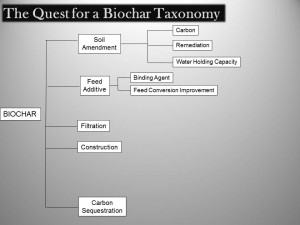One of the hurdles biochar sometimes faces is that it often gets portrayed as the solution for everything. I’ve now read enough biochar literature to be both impressed by its multifaceted abilities and yet knowledgeable enough to know that it is not going to be the solution to every problem thrown its way, especially since the word biochar covers an almost endless variety of products, some of which have no business parading around under the biochar banner.
Low tech multifaceted products are not uncommon. There are countless uses for things like baking soda, vinegar, egg shells and more. These don’t really need to be further classified as different flavors of each of these seems to be able perform the various functions to a similar standard.
All-encompassing words used to describe a basic structure or to describe a particular end use are also plentiful (e.g. ‘tree’ or ‘plastic’). These words are undoubtedly helpful in getting us to a certain level of understanding but often times we really need to know more than just the Genus (or should that be the ‘Family’ level in the taxonomy structure? Who knows!). Biochar is one of those words and it is screaming out for its very own taxonomy. (Can’t you hear it screaming?)
This should not be confused with the efforts to characterize biochar which are moving along in various parts of the world thanks to the efforts of the International Biochar Initiative and the European Biochar Certification program. However both of these voluntary programs are mainly focused on biochar used in soils. Moving forward there appears to be a growing number of applications for biochar. Different characteristics will likely be important for the different end uses. This is the notion of ‘Designer Biochars’ which one is beginning to hear more and more about amongst the biochar literati.
So Biochar community, perhaps it is time to start creating a ‘Species’ level for biochar so that we begin to clarify the biochar message a bit more, so that the benefits touted to consumers will more accurately align with the biochar being sold for particular end uses, and so that the testing done on the chars is appropriate for its intended end use.
Shall we do that by feedstock (e.g. manure char, woody char, etc.) or by production (e.g. high temp pyrolysis, gasified, TLUD chars) or by end use (e.g. remediation char, sequestration char, feed char)? Personally I’m a fan of the last one but I suspect there are a variety of opinions out there. I am very curious as to what others in the industry think…
[Shout out to Thea Whitman from Cornell who first enlightened me on the analogy of how the way the word ‘biochar’ is used is similar to the way the word ‘tree’ is used!]


